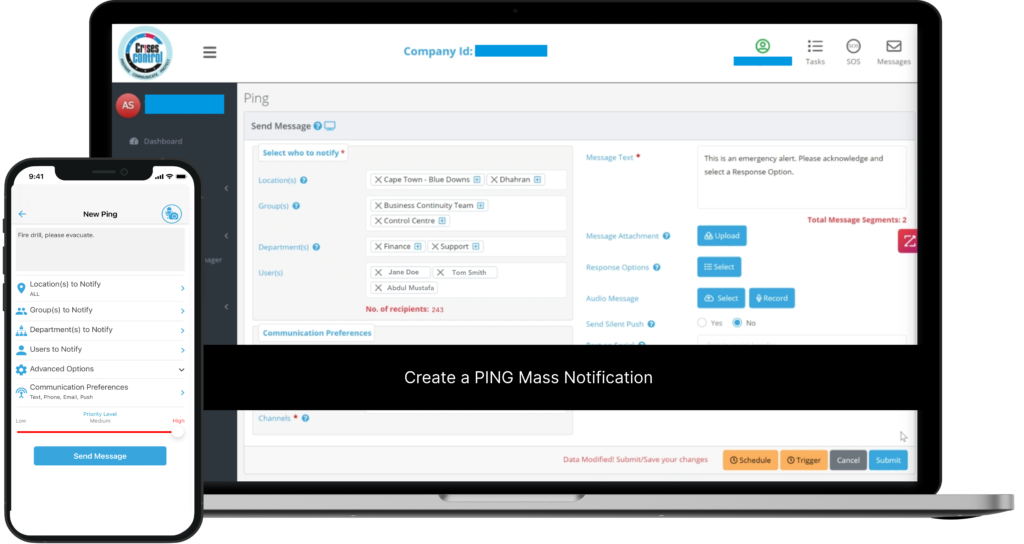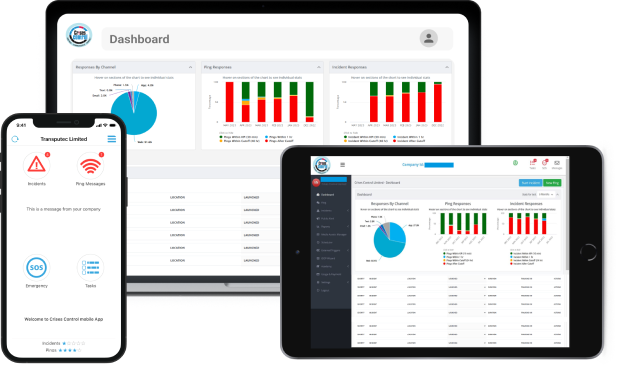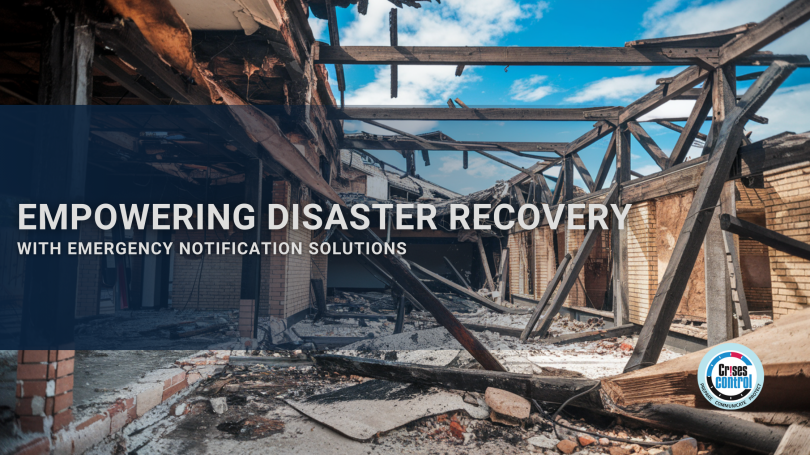Written by Ikram Tassi | Marketing
When a disaster strikes—whether it’s a natural event like a hurricane, a cybersecurity breach, or an unexpected power outage—the pressure is on. Every minute counts, and swift, clear communication is essential for a fast recovery. In these high-stakes situations, emergency notification solutions are the lifeline that businesses need to respond quickly and minimise the impact of the disaster.
In the chaos of a crisis, how quickly can you get the right information to the right people? How fast can your teams act to mitigate further damage? The effectiveness of your communication strategy will often determine whether your business can recover in hours or days.
This blog will explore the critical role emergency notification solutions play in disaster recovery. We’ll look at how these systems help organisations communicate in real time, minimise downtime, and return to normal operations as quickly as possible. We’ll also highlight how Crises Control, a leading mass notification system, is designed to make your business more resilient, no matter what crisis you’re facing.
The Importance of Real-Time Communication in Disaster Recovery
In a disaster, the speed and clarity of your communications are crucial. When things go wrong—whether it’s a fire, system outage, or cyber attack—the clock starts ticking. The faster your teams are informed and able to respond, the more damage you can prevent.
Without real-time communication, confusion can quickly spread. Important decisions get delayed, and employees are left unsure of what steps to take. During a crisis, your communication system should provide immediate clarity to everyone involved.
Real-time communication also reduces the likelihood of human error. When you’re sending out alerts and updates, the last thing you want is to rely on slow or outdated methods like manual phone calls or emails. A mass notification system can reach thousands of people simultaneously, ensuring that everyone receives the most up-to-date information, regardless of their location.
The speed of communication directly correlates to the effectiveness of your crisis response. With Crises Control, businesses can send mass alerts through multiple channels (SMS, email, mobile app notifications, voice calls) in seconds. Whether it’s a natural disaster or a technical emergency, your teams can be informed, aligned, and ready to act immediately.
The Role of Emergency Notification Solutions in Disaster Recovery
In times of disaster, emergency notification solutions are your first line of defence. These systems make it possible to instantly notify key personnel and stakeholders, ensuring that everyone is on the same page and responding appropriately. But how exactly do they help businesses recover quickly? Let’s break it down.
1. Instant Alerts to the Right People
One of the most important features of emergency notification solutions is their ability to reach the right people at the right time. A disaster is a high-pressure situation, and you don’t have time to figure out who needs to be notified.
With Crises Control, you can send alerts to your entire workforce, specific teams, or key stakeholders instantly. Whether your employees are in the office, at home, or on the move, you can ensure they get the critical information they need in seconds. This is especially important when you have remote teams or multiple locations that need to be coordinated for a unified response.
2. Deliver Clear, Actionable Information
When a crisis hits, it’s not enough just to say “there’s an emergency.” You need to send clear, actionable messages that guide employees through the steps they need to take.
Crises Control allows you to send pre-designed templates for various types of crises. These templates ensure that your messaging is clear, direct, and actionable. Whether you’re instructing employees to evacuate the building or warning them about a system compromise, Crises Control ensures that your instructions are delivered concisely and without confusion.
3. Centralised Communication Hub
Managing a disaster is chaotic, and it’s easy to lose track of who’s been notified or what’s been communicated. Having a centralised communication hub is key to maintaining control during a crisis. Crises Control acts as this hub, allowing you to monitor all incoming and outgoing communication.
You can track the progress of recovery efforts in real time, check which messages have been received or acknowledged, and adjust your strategy if necessary. This centralised visibility ensures that you’re never in the dark about the status of the crisis or your recovery efforts.
Interested in our Ping Mass Communication Software?
Efficiently alert everyone in seconds at scale with our Mass Communication Software – PING, get the message out fast and ensure rapid response and recovery.

How Crises Control Streamlines Disaster Recovery
Let’s take a closer look at how Crises Control, a leading emergency notification solution, can help streamline disaster recovery for businesses.
1. Automated Alerts and Messaging
One of the most powerful features of Crises Control is its ability to automate the notification process. During a disaster, you don’t have time to manually send out alerts. Automated alerts ensure that messages go out the moment a crisis is detected.
If a critical system goes down or a natural disaster hits, Crises Control can automatically send out notifications to key personnel without any manual intervention. This speeds up your response time and helps minimise the impact of the disaster.
2. Multi-Channel Communication
Effective communication requires more than just one channel. Imagine if your team only relied on email during a fire or power outage. With no power, email wouldn’t be reliable.
Crises Control ensures your notifications reach your team through multiple channels—SMS, email, voice calls, push notifications, and even social media. This redundancy is critical in ensuring your message reaches everyone, no matter what communication infrastructure is affected by the crisis.
3. Targeted Messaging for Different Groups
In an emergency, not all employees need the same information. Some may need to know evacuation procedures, while others might need to take immediate actions to protect critical systems or data.
With Crises Control, you can send targeted messages to specific groups or departments. For example, the IT team can receive alerts about a network breach, while employees in physical locations get information about evacuations. This ensures that everyone is getting the right message at the right time.
4. Real-Time Reporting and Monitoring
Real-time reporting is an essential feature for crisis management. You need to know what’s happening right now, who’s received the alerts, and which actions have been taken.
With Crises Control, you get detailed reports on who acknowledged the alerts, who’s taken action, and what recovery steps are in progress. This real-time visibility allows you to make data-driven decisions and adjust your recovery strategy as necessary.
5. Customisable Alerts and Templates
Every disaster is unique, but the need for clear, effective communication remains the same. Crises Control offers customisable templates for different crisis scenarios. This flexibility ensures that your alerts are always on-point and relevant to the specific situation. Whether you’re dealing with a system outage, a natural disaster, or a security breach, you’ll have the tools to communicate effectively.
Key Benefits of Mass Notification Systems for Disaster Recovery
Here are some key benefits of using mass notification systems like Crises Control in your disaster recovery efforts:
1. Speed and Efficiency
Speed is crucial when responding to an emergency. Crises Control allows you to send messages to thousands of people in seconds, ensuring that your team can respond quickly and effectively.
2. Employee Safety
In a crisis, employee safety is always the top priority. With Crises Control, you can send emergency alerts with safety instructions, evacuation plans, and emergency contact information. This helps ensure that your employees are informed and safe during a crisis.
3. Business Continuity
A reliable emergency notification solution helps maintain business continuity by minimising downtime and accelerating the recovery process. When your teams are informed and aligned, they can work more efficiently to restore normal operations.
4. Compliance and Accountability
For businesses subject to regulatory requirements, Crises Control ensures that your crisis response efforts are documented. The system logs all notifications, actions, and recovery steps, providing a clear record for compliance purposes and post-crisis evaluation.
Conclusion: Empower Your Business with Crises Control
Disasters are unpredictable, but with the right emergency notification solutions, your business can handle them with confidence. Clear, real-time communication is essential for minimising damage, ensuring safety, and speeding up the recovery process.
With Crises Control, you gain access to a comprehensive, multi-channel mass notification system that empowers your business to communicate quickly and effectively during a crisis. From automated alerts to real-time reporting, Crises Control streamlines disaster recovery and ensures that your team is always prepared.
Ready to see how Crises Control can transform your disaster recovery strategy? Contact us today for a free demo and discover how our emergency notification solutions can make your business more resilient, no matter what challenges you face.
Request a FREE Demo

